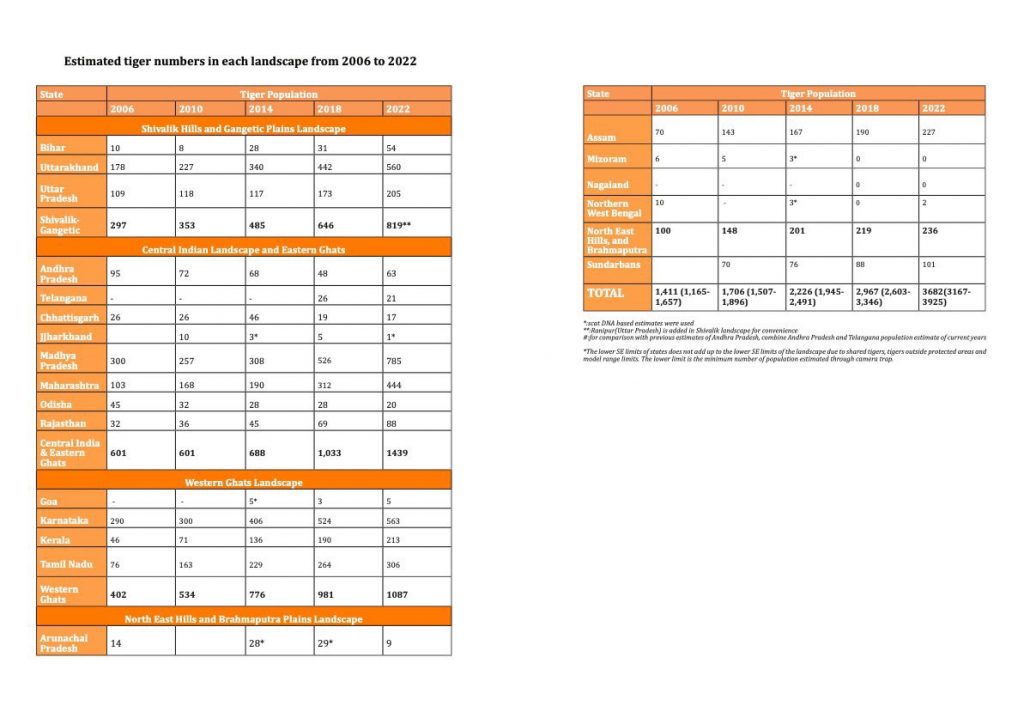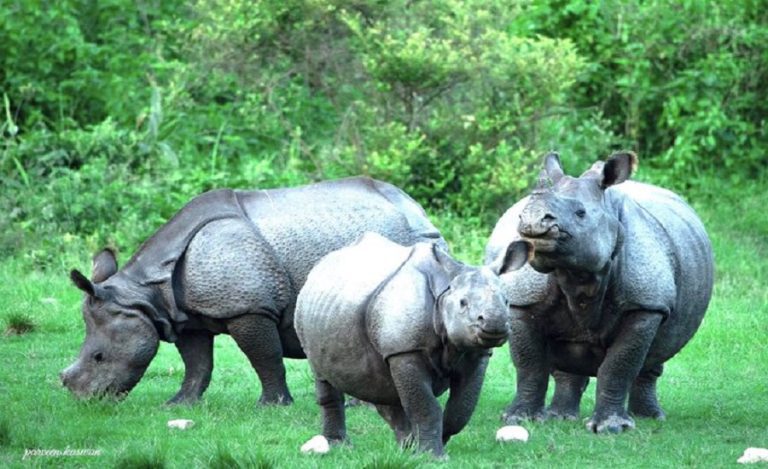India Tiger Census 2022 was released by PM Modi in Karnataka’s Mysuru on the occasion of 50 years of Project Tiger on April 9, 2023. And now, state and tiger reserve-wise breakup of the census, has been released at the Corbett Tiger Reserve by Union Minister of State for Environment, Forest and Climate Change, Mr. Ashwini Kumar Choubey on the occasion of as celebrating Global Tiger Day. He also released a detailed report on Management Effectiveness Evaluation (MEE), which is the most important tool in tiger conservation.
Madhya Pradesh has once again emerged the state with largest number of tigers and got the title of Tiger State. It houses 785 tigers outnumbering other states by huge margin.
In last four years, the state has added 259 tigers to its kitty. This is the highest in the country. While in last census in 2018, Madhya Pradesh had 526 tigers. It has been declared as Tiger State for the second consecutive time. In the first census in 2006, the state was on the first position. After that, MP has been number one in 2018 and now in 2022.
Karnataka with 563 and Uttarakhand with 560 tigers are at second and third spot respectively.

Among Tiger Reserves, Uttarakhand’s Jim Corbett National Park has the highest number of tigers at 260 within the reserve, while 319 tigers utilising the tiger reserve. Karnataka’s Bandipur and Nagarhole tiger reserve are at seconds and third positions with 150 tigers and 141 tigers, respectively. Madhya Pradesh’s Bandhavgarh Tiger Reserve came forth with 135 tigers with tiger reserve and 165 tiger utilising the tiger reserve. Uttar Pradesh’s Dudhwa National Park is at fifth number with 135 tigers within tiger reserve and 153 tiger utilising the tiger reserve.
In last census in 2018, Jim Corbett National Park had 231 tigers. While Karnataka’s Bandipur was having 126 and Nagarhole tiger reserve having 127 tigers.
Arunachal Pradesh’s Kamlang Wildlife Sanctuary, established in 1989 and the 50th Tiger reserve in India, and Mizoram’s Dampa Tiger Reserve has 0 tiger. While West Bengal’s Buxa Tiger Reserce shows minor growth and has 1 Tiger. In last census, there was 0 tiger in Buxa.

12 Tiger Reserves have achieved the ‘Excellent’ category, followed by 21 Tiger Reserves in ‘Very Good’, 13 Tiger Reserves in ‘Good’ & 5 Tiger Reserves in ‘Fair’ in the Management Effectiveness Evaluation (MEE) of Tiger Reserves, 2022, released on the occasion of International Tiger Day 2023.
Periyar Tiger reserve in Kerala tops the 5th cycle of Management Effectiveness Evaluation (MEE) of Tiger Reserves, 2022. And we have a tie in second place with Satpura TR, Madhya Pradesh &
Bandipur TR in Karnataka.
Thus, Periyar, Satpura, Bandipur, Nagarhole & Kanha make the top 5 places in the Management Effectiveness Evaluation (MEE) in 2022 list.

The Conservation Assured Tiger Standards (CATS) award for the conservation, maintenance & better management of tigers goes to 6 Tiger Reserves- Kali, Melghat, Pilibhit, Tadoba-Andhari, Nawegaon-Nagzira & Periyar.
The report also said that tiger populations have also declined in the central Indian states of Jharkhand, Odisha, Chhattisgarh, Andhra Pradesh and Telangana, even though tigers have been spotted for the first time in Himachal Pradesh and in new areas in Madhya Pradesh and Maharashtra.
Proud moment for India! With a 6.1% annual growth rate, tiger population stands at 3682. #GlobalTigerDay#InternationalTigerDay#InternationalTigerDay2023#MissionLiFE#ProPlanetPeople pic.twitter.com/QXNdUgxkSN
— MoEF&CC (@moefcc) July 29, 2023
The only landscape in India where the tiger population has gone down is Western Ghats, where declaring of the ecologically sensitive zone has been hanging since 2010.
Congratulations, Madhya Pradesh!
— Bhupender Yadav (@byadavbjp) July 29, 2023
With 785 tigers as per the latest tiger estimation exercise, MP is the Leading Tiger State of India!
This reflect MP’s commitment to conserving tigers through intensive protection and monitoring by involving local communities.#TigersInMP pic.twitter.com/DGYtSMjoGe
India since 2006 has been conducting scientific tiger population estimation once every four years. According to the latest report, the country is home for 75% of the wild tigers in the world. The number was 1,411 in 2006. The sustained efforts in tiger reserve management since 2014, have added another batch of 6 tiger reserves in to the prestigious international CA|TS accreditation club.































